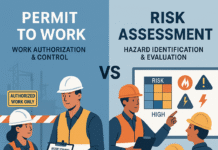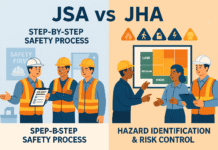
Confined Space Entry Risk Assessment
📘 Introduction
Think about climbing into a storage tank, a manhole, or a small tunnel where there’s limited air, tight space, and one way in and out. Sounds risky, right? That’s what confined space entry is all about—working in environments that can quickly turn from dangerous to deadly.
That’s why a Confined Space Entry Risk Assessment is more than just a checklist—it’s your lifeline. Done correctly, it prevents fatalities, ensures legal compliance, and gives your team the confidence to work smart and safe.
In this guide, we’ll walk through everything you need to know to conduct a complete confined space risk assessment, including hazards, control measures, rescue planning, and a sample risk matrix.
📜 Legal & Regulatory Framework
What’s Considered a Confined Space?
A confined space is any area that is:
- Large enough to enter and perform work,
- Has limited or restricted means of entry and exit,
- Not designed for continuous occupancy.
Examples include:
- Storage tanks
- Manholes
- Silos
- Tunnels
- Vessels
- Pits
Applicable Regulations
- OSHA 29 CFR 1910.146 – Permit-Required Confined Spaces
- UK HSE – Confined Spaces Regulations 1997
- Indian Factories Act + IS 13349:1992
- ISO 45001 – Hazard Identification and Risk Control
⚠️ Common Confined Space Hazards
| Hazard Type | Examples |
|---|---|
| Oxygen Deficiency | Below 19.5% O₂, causes unconsciousness |
| Toxic Atmosphere | H₂S, CO, solvents, welding fumes |
| Flammable Gases | Methane, propane, vapors from fuels |
| Engulfment | Loose material like grain or sludge |
| Physical Hazards | Heat stress, sharp edges, poor lighting |
| Access/Egress | One exit, slippery surfaces, vertical descent |
🎯 Why Risk Assessment is Critical
- Confined spaces can look harmless but kill silently.
- Most deaths happen to would-be rescuers.
- Risk assessment helps preempt danger, protect lives, and comply with law.
📊 Confined Space Risk Matrix (5×5)
| Severity ↓ / Likelihood → | Rare (1) | Unlikely (2) | Possible (3) | Likely (4) | Almost Certain (5) |
|---|---|---|---|---|---|
| Insignificant (1) | 1 | 2 | 3 | 4 | 5 |
| Minor (2) | 2 | 4 | 6 | 8 | 10 |
| Moderate (3) | 3 | 6 | 9 | 12 | 15 |
| Major (4) | 4 | 8 | 12 | 16 | 20 |
| Catastrophic (5) | 5 | 10 | 15 | 20 | 25 |
- Low (1–3): Acceptable risk
- Medium (4–6): Mitigate before entry
- High (7–15): Strict controls required
- Extreme (16–25): Do not proceed without redesign or major control
📌 Confined Space Risk Assessment Table
| S.No | Activity | Hazard | Risk (L×S) | Risk Level | Control Measures | Responsible Person |
|---|---|---|---|---|---|---|
| 1 | Entry into tank | Oxygen deficiency | 5×5 = 25 | Extreme | Atmospheric testing, mechanical ventilation, oxygen meter, rescue plan | Safety Officer |
| 2 | Cleaning sludge from pit | Toxic gas exposure (H₂S, CO) | 4×5 = 20 | Extreme | Gas detectors, SCBA, continuous monitoring, buddy system | Confined Space Supervisor |
| 3 | Welding inside vessel | Fire and explosion | 3×5 = 15 | High | Hot work permit, LEL test <10%, fire extinguisher, fire watch | Permit Issuer |
| 4 | Entry through manhole | Fall hazard | 3×4 = 12 | High | Tripod with winch, full body harness, standby person | Entrant & Attendant |
| 5 | Extended work in hot space | Heat stress | 3×3 = 9 | High | Water breaks, cool clothing, ventilation, rest cycles | Supervisor |
| 6 | Removing liquid waste | Drowning / engulfment | 2×5 = 10 | High | De-water area first, wear harness, rescue readiness | Entry Team Leader |
| 7 | Emergency evacuation | Lack of rescue equipment | 5×4 = 20 | Extreme | Pre-rig rescue tripod, train attendants, simulate drills, rescue plan signed | Site HSE Manager |
🛠 Permit to Work (PTW) for Confined Spaces
Never enter a confined space without a valid permit.
PTW Should Include:
- Job details and location
- Hazard identification
- Atmospheric test results
- Isolation status
- PPE requirements
- Rescue arrangements
- Signatures of all involved
🛑 No Permit = No Entry. Ever.
🔍 Gas Testing: The Life-Saving Step
Use calibrated gas detectors to check:
- Oxygen (O₂) – Minimum 19.5%
- Flammable Gases (LEL) – Below 10%
- Toxics (H₂S, CO, NH₃) – Within permissible exposure limits
Testing must be continuous or at frequent intervals.
🧰 PPE and Equipment Required
- SCBA (Self-Contained Breathing Apparatus)
- Tripod with retrieval system
- Gas detector (4-gas or 5-gas)
- Full-body harness with shock absorber
- Fire-resistant coveralls
- Headlamp or intrinsically safe torch
- Two-way radios or hand signals
🚨 Emergency & Rescue Planning
Must Include:
- Trained rescue team on standby
- Rescue tripod and winch ready
- Backboard/stretcher at site
- Emergency medical team on alert
- Emergency numbers posted
- Practice drills
❗ Never send untrained personnel inside to rescue.
🎓 Training & Competency
Only trained and authorized personnel may enter confined spaces.
Required Training:
- Hazard recognition
- Use of gas detectors
- Donning SCBA and harness
- Rescue techniques
- First aid and CPR
Training should be refreshed annually and after any incident.
📋 Documentation & Records
Ensure you maintain:
- Risk assessments
- PTW copies
- Gas test logs
- Entry/exit logs
- Rescue plans
- PPE inspection records
Keep documents on-site and signed.
❌ Common Mistakes to Avoid
- Skipping gas testing
- Using expired equipment
- No rescue plan
- Sending untrained workers
- No communication system
- Poor lighting or access
💡 Best Practices
- Use checklists before and after entry.
- Always have standby rescue personnel.
- Isolate energy sources (LOTO).
- Keep permits visible at entry point.
- Use signage like “Danger: Confined Space Entry Only”.
✅ Conclusion
Confined spaces can kill—silently and quickly. But with the right risk assessment, controls, and preparation, you can enter and exit safely.
A thorough Confined Space Entry Risk Assessment isn’t just paperwork—it’s your first and best protection. It ensures that everyone goes home safe, every time.
Working at Height Risk Assessment
Chemical Processing Risk Assessment
Manufacturing Plant Risk Assessment
Construction Site Risk Assessment
❓ Frequently Asked Questions (FAQs)
1. What makes a space “confined”?
A space is confined if it has limited access, is not meant for continuous occupancy, and can present life-threatening hazards.
2. Is gas testing always required?
Yes. You must test for oxygen, toxic gases, and flammable vapors before and during entry.
3. Can anyone enter a confined space?
No. Only trained, competent, and authorized personnel may enter. PTW must be issued.
4. Is a rescue plan mandatory?
Yes. A written and practiced rescue plan is required by law in most jurisdictions.
5. What if there is only one worker available?
Entry into a confined space alone is strictly prohibited. A team setup is mandatory with attendant and rescue arrangements.
























